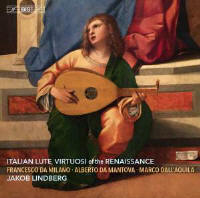Texte paru dans: / Appeared in: |
|
|
Reviewer: Barry
Brenesal
The liner notes to this
release cleverly draw their content together at the beginning with a quote:
“Whilst all wind and string instruments are sweet … the suavity of sound
which the lute gives birth to when touched by the divine fingers of
Francesco Milanese, Alberto da Mantova and of Marco dall’Aquila, robs the
senses of those listening by making itself heard in the soul.” The
assumption one is led to make is that the writer heard them all, and is
recording straightforward impressions. It is, without question, eminently
quotable. Yet its author, Francesco Marcolini, was a Venetian printer, and
this comment of his is drawn from remarks meant to sell his 1536 publication
of Milanese’s (invariably called da Milano, today) works, including the
Intabolutura de liuto de diversi…di Messer Francesco da Milano. That adds a
twist to his enthusiasm, for it is an advertisement meant to sell his wares,
and one can almost hear him continue—if only in imagination, “The cost in
ducats for my premium edition in soft, gold-embossed Cordovan leather is as
nothing compared to the joy you will get from playing such divine music!
Will there be anything else? How about the Fifth Book of Masses by our great
maestro di cappella at St. Mark’s, Adrian Willaert, also just issued by my
publishing house?”
Francesco Da Milano was easily
the most famous of the three lutenist-composers. His music survives in over
60 printed and manuscript sources. Alberto da Mantova’s work can be found in
11 extent books, while the music of Marco dall’Aquila—who, ironically
enough, secured a 10-year privilege to print music from Venice’s Ducal
Council—exists today in quantity in only a single manuscript. (There’s also
a collection of lute music published by Giovanni Antonio Castelione in 1536
that includes three fantasias of his.) All three composed and performed in
the early 16th century, though it’s unlikely they would have crossed paths,
Marcolini’s misleading flattery notwithstanding. Francesco, as his sobriquet
indicates, spent much of his time in Milan, and effectively wherever his
Medici and Farnese patrons required, while Alberto was much esteemed by
Francis I and his successor to the French throne, Henry II. Marco, in turn,
spent nearly all his life in Venice. Professional lutenists were common
during the period, so much so that the coinage was to an extent debased, and
it was difficult for many to find secure employment, or good pay when they
did. But these three, each in his own way, rose to the top of the
profession, and was recognized as such by their enthusiastic patrons.
The music of all three is
usually quite difficult to perform, as another fine lutenist, Paul O’Dette,
observed upon recording an album of Francesco’s works. Counterpoint is
complex and tricky to clarify. Rhythms, when noted, can be highly irregular,
at least in the ricercars and fantasias that make up a significant portion
of the lute music from the period. Melodic lines move very quickly, usually
in divisions or ornamentation over complex harmonic changes (a good example
Lindberg points to is Alberto’s improvisation on Sebastiano Festa’s madrigal
O passi sparsi). It is not enough to play it correctly. It must be performed
with attention to phrasing, tone, dynamics, and finger positioning.
Lindberg comes off admirably.
As I noted in a review of another album of his (Jacobean Lute Music, BIS
2055, Fanfare 37:5), his articulation is excellent. Faster pieces “are
tossed off with deceptive ease,” while slower ones allow him to explore a
realm of color. He structures this release sensibly, dividing the 26 pieces
on the album into groups of three or four works by a given composer. Each
group is built around key relationships, shifts of tempo, and expressive
mood. The album has its high stepping dances, such as Marco’s saltarello La
Traditora and Alberto’s divisions on La Romanesca, but the more memorable
things are the vocal intabulations and fantasias—among the former,
Francesco’s deceptively simple version of Arcadelt’s Quanta beltà, and among
the latter, his ruminative and subtly constructed Fantasia 55. The engineering is excellent, close and rich, with just enough ambiance to let the tone of Lindberg’s six-course lute sound beautifully. Warmly recommended. | |
|
|
|
|
|
|
|
Cliquez l'un ou l'autre
bouton pour découvrir bien d'autres critiques de CD |
|




